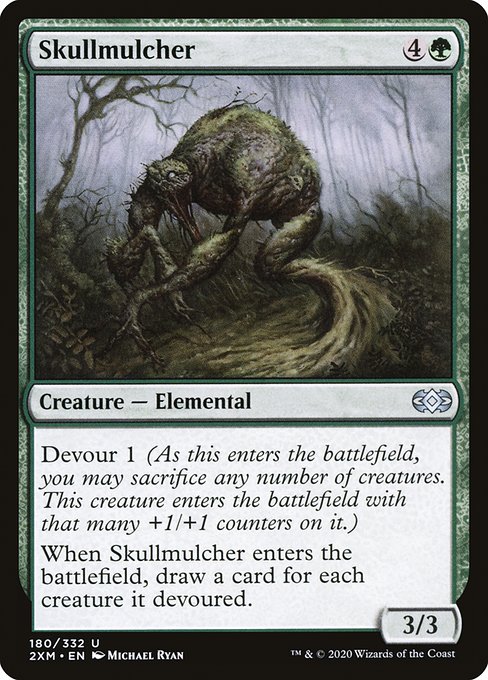
Image courtesy of Scryfall.com
Skullmulcher: A Case Study in Art Reprint Frequency
If you’re a fan of both green stompy monsters and data-driven MTG conversations, Skullmulcher is a neat bellwether for how artwork travels through the multiverse. This gritty green Elemental from the Double Masters set (the 2xm batch released in 2020) is more than just a beefy value engine — it’s a lens on how Wizards reuses and refreshes art across reprints. With its {4}{G} mana cost and a tidy 3/3 body, Skullmulcher stands as a surprisingly efficient tool for sacrifice-centric decks while also acting as a canvas for examining how often certain images pop up again in new print runs. 🧙♂️🔥💎
From a data perspective, Skullmulcher is marked as a reprint in the Double Masters era, with the card listed as an uncommon in the 2xm print run. The original art, crafted by Michael Ryan, remains consistent across the available prints, including foils and nonfoils. This consistency is the key signal in our frequency analysis: when an art arrives in a set as a reprint, it often reappears only in select subsequent reprint cycles unless a new artwork is commissioned. In Skullmulcher’s case, the “reprint” flag in the dataset points to a deliberate reuse rather than a reimagined version. The result is a familiar face in markets where players chase both nostalgia and solid creature-advantage plays. ⚔️🎨
Devour 1 (As this creature enters, you may sacrifice any number of creatures. It enters with that many +1/+1 counters on it.) When this creature enters, draw a card for each creature it devoured.
That flavor text isn’t just thematic window dressing; it’s a mechanical engine. Skullmulcher rewards sacrifice with incremental card draw, turning a board of chaff into a flood of options as it enters the battlefield. The synergy is classic Golgari-ish design: convert creatures into resources, then swing with a resilient threat. In practice, Skullmulcher fits neatly into green builds that lean on mass-sacrifice or value-driven enticements. It’s not a one-card combo, but in a deck that already supplies fodder, Skullmulcher becomes a reliable source of both raw power and card advantage. 🧙♂️💥
From a collector’s perspective, the Double Masters reprint brings this card into the modern era with foil and nonfoil finishes, which matters for price floors and display value. The data shows modest price points for nonfoil printings (as of the current snapshot, around $0.12 USD) and a bit higher for foils (around $0.17 USD). While Skullmulcher isn’t a marquee rare, its presence in a Masters-format set ensures it remains broadly accessible for players who want to slip an efficient, devour-enabled threat into their green builds without chasing chase rares. The availability also supports EDH players who prize out-of-rotation cards that still deliver on a long-term strategy. 💎🧩
Design-wise, Skullmulcher’s art emphasizes the visceral, gnarled energy of a creature that devours other beings to become stronger. That visual language mirrors the mechanical idea of growth through sacrifice—a narrative thread you’ll notice across many green strategies that flirt with value through costed downsides. The art’s palette, with mossy greens and bone-white highlights, communicates both life and death in a single frame, a tonal choice that resonates with players who enjoy the “creature-into-lurther” arc of green. In a meta where artwork often becomes a collectible in its own right, Skullmulcher’s consistent art across its reprint helps preserve a stable visual identity for fans who fondly recall the original print. 🎨🧪
Strategically, Skullmulcher’s presence in a deck often prompts opponents to weigh removal timing and sacrifice flow. If you’re piloting a deck built around token creation, you can leverage Skullmulcher as a powerful engine that converts your own expendable bodies into card draw and a threatening+1/+1 boost. Since the card’s mana cost sits at five (four colorless and one green), it sits in a comfortable midrange slot, enabling you to ramp into it while preserving enough mana to leverage arcane interactions or protective plays. The art reprint frequency, in this sense, doesn’t just affect the card’s collectability; it informs a player’s sense of how likely they are to see the same image across multiple reprint cycles, which can influence deck-building nostalgia and table talk. 🧙♂️⚔️
For those who chase value, Skullmulcher’s data points—set, rarity, and reprint status—are a useful microcosm of how Wizards manages iconic visuals within a modern Masters era. The card remains a glyph of green’s resilience and a reminder that art, like strategy, can stay relevant across multiple printings. The fact that this artifact of a creature’s devouring journey retains its visual identity across prints is a nod to the way MTG’s history unfolds in a way that fans can recognize and celebrate. 🔥💎
Non-Slip Gaming Mouse Pad — 9.5x8in